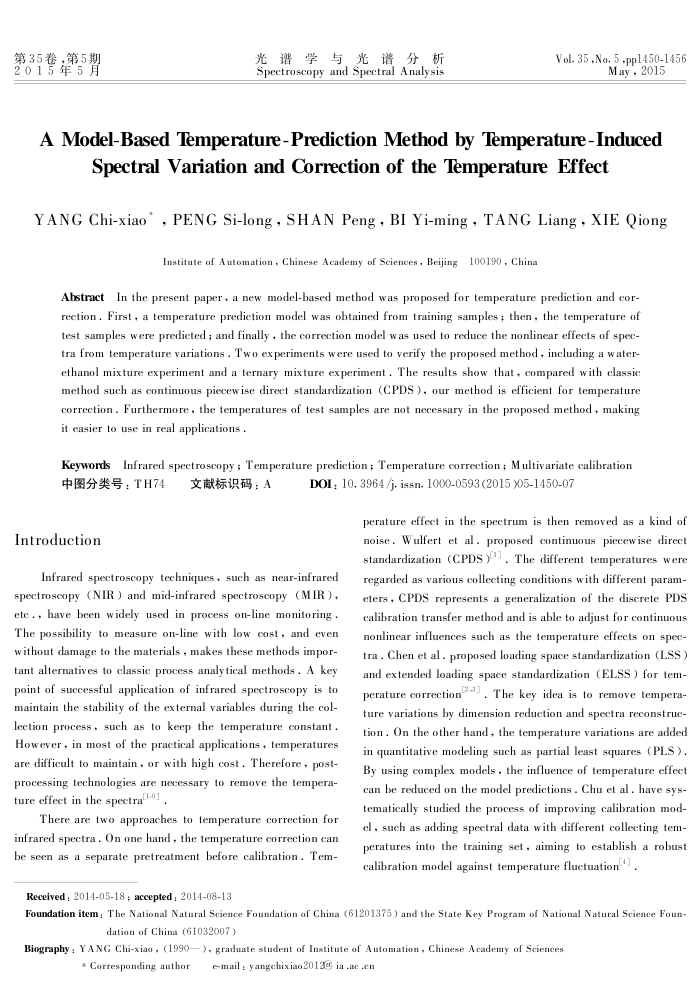您当前的位置:首页>论文资料>基于模型的红外光谱温度预测及校正方法
内容简介
 第35卷,第5期 2015年5月
第35卷,第5期 2015年5月光谱学与光谱分析 Spectroscopy and Spectral Analysis
Vol.35,No, 5 -ppl450-1456
May,2015
A Model-Based Temperature-Prediction Methodby Temperature-Induced
SpectralVariationandCorrectionoftheTemperatureEffect
YANGChi-xiao,PENG Si-long,SHANPeng,BIYi-ming,TANGLiang,XIE Qiong
Institute of Automation, Chinese Academy of Sciences, Beijing100190, China
Abstract In the present paper , a new model-based method was proposed for temperature prediction and cor rection. First, a temperature prediction model was obtained from training samples : then , the temperature of test samples were predicted ; and finally , the correction model w as used to reduce the nonlinear effects of spec-tra from temperature variations . Two experiments were used to verify the proposed method , including a water-ethanol mixture experiment and a ternary mixture experiment . The results show that , compared with classic method such as continuous piecewise direct standardization (CPDS ), our method is efficient for temperature correction . Furthermore, the temperatures of test samples are not necessary in the proposed method , making it easier to use in real applications .
Keywords Infrared spectroscopy ; Temperature prediction ; Temperature correction ; Multivariate calibration
中图分类号:TH74
Introduction
文献标识码:A
DI; 10. 3964 /j. issn. 1000-0593 (2015 )05-1450-07
perature effect in the spectrum is then removed as a kind of noise. Wulfert et al. proposed continuous piecewise direct standardization (CPDS )). The dfferent temperatures were
Infrared spectroscopy techniques , such as near-infrared spectroscopy (NIR) and mid-infrared spectroscopy (MIR), etc ., have been widely used in process on-line monitoring . The possibility to measure on-line with low cost , and even without damage to the materials , makes these methods impor-tant alternatives to classic process analytical methods . A key point of successful application of infrared spectroscopy is to maintain the stability of the external variables during the col-lection process, such as to keep the temperature constant. However , in most of the practical applications , temperatures are difficult to maintain , or with high cost, Therefore + post-processing technologies are necessary to remove the tempera-ture effect in the spectra-91
There are two approaches to temperature correction for infrared spectra . On one hand, the temperature correction can be seen as a separate pretreatment before calibration. Tem-
Received : 2014-05-18 ; accepted : 2014-08-13
regarded as various collecting conditions with different param-eters, CPDS represents a generalization of the discrete PDS calibration transfer method and is able to adjust for continuous nonlinear influences such as the temperature effects on spec-tra . Chen et al. proposed loading space standardization (LSS) and extended loading space standardization (ELSS ) for tem-perature correction2), The key idea is to remove tempera-ture variations by dimension reduction and spectra reconstruc-tion. On the other hand, the temperature variations are added in quantitative modeling such as partial least squares (PLS). By using complex models , the influence of temperature effect can be reduced on the model predictions . Chu et al . have sys-tematically studied the process of improving calibration mod-el , such as adding spectral data with different collecting tem-peratures into the training set, aiming to establish a robust calibration model against temperature fluctuation)
Foundation item: The National Natural Science Foundation of China (61201375) and the State Key Program of National Natural Science Foun-
dation of China (61032007)
Biography : YANG Chi-xiao , (1990—), graduate student of Institute of Automation , Chinese Academy of Sciences
Corresponding author
e-mail : yangchixiao201@ ia ac .cn